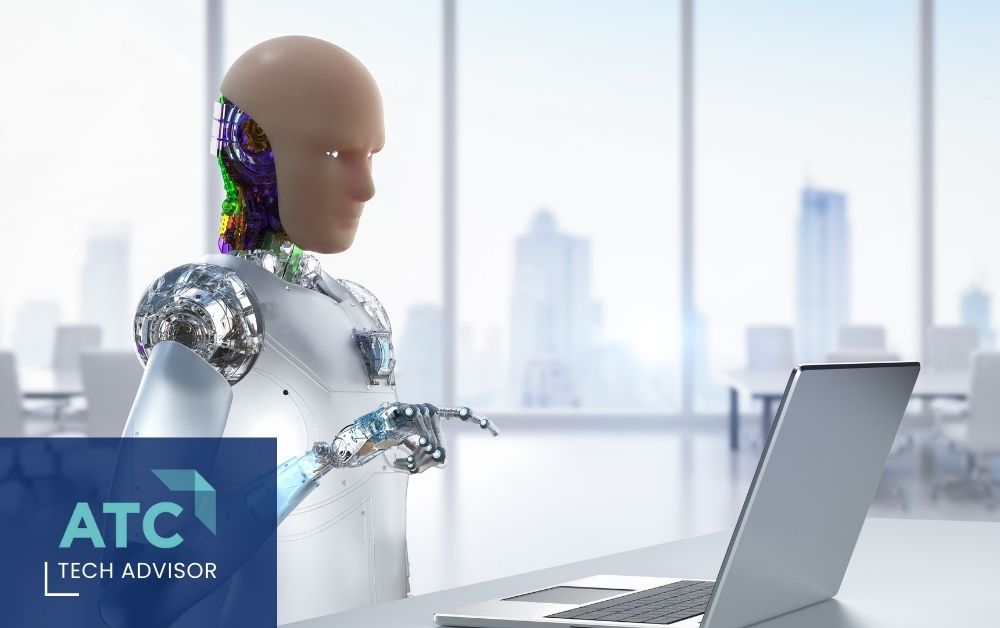
If you’ve landed here, you’re probably looking to understand more about implementing AI in your workplace. You’ve come to the right place. At ATC, we’ve heard from many business leaders that having a comprehensive guide to implementing AI helps them navigate an otherwise complex process.
The AI implementation process can be transformative, offering solutions to enhance productivity, efficiency and digital innovation. Whether you’re a seasoned CIO or just beginning your AI journey, this article guides you through the critical steps necessary to successfully integrate AI into your organization.
And, if you want to dive deeper, check out our free downloadable guide: Implementing AI in the Workplace.
1. Understanding Your Business Objectives
The first step in implementing AI is identifying the business objectives it can address:
- Customer service
- Supply chain management
- Human resources or talent management
- Cybersecurity
- And more
For example, implementing AI-powered chatbots can revolutionize customer service by providing instant responses to inquiries, handling routine requests and offering personalized recommendations. This not only enhances customer satisfaction but also frees up your human resources to focus on more complex tasks.
2. Assessing Your Infrastructure and Systems
Before diving into AI implementation, it’s crucial to evaluate your current capabilities, including:
- Data infrastructure
- Cloud solutions
- IT systems and technologies
- Network infrastructure
This type of assessment will help you determine the readiness for AI adoption and identify any gaps that need to be addressed in key areas.
3. Managing Your Data
Ensure your data is complete, accurate and available in a structured and accessible format. Consider your ability to integrate data from various sources and review your data storage solutions for scalability and performance. Robust data management practices and data security measures are essential to protect sensitive information and ensure compliance with regulations such as GDPR, CCPA and HIPAA.
4. Evaluating the Performance of Your IT Systems
Evaluate the performance and capacity of your current hardware and software systems. Ensure your infrastructure can support the computational demands of AI applications, assess your cloud capabilities and review network infrastructure for handling increased data traffic.
5. Developing a Data Strategy
Develop a robust data strategy to ensure access to high-quality data for training AI models. This includes data collection, storage, cleaning and governance processes. Implement measures to maintain data privacy and security throughout the AI lifecycle.
6. Choosing the Right AI Technologies
Choose the right AI technologies and tools based on the use cases of your business and technical requirements. Consider factors such as scalability, interoperability and vendor support. Hiring a team of strategic technology consultants can help analyze your business needs and recommend tailored AI solutions, potentially saving you time and money.
Ready to Transform Your Business by Implementing AI?
Good news: Now that you’ve become more familiar with the steps you need to take to start the AI implementation process, you can gain more valuable insights with a copy of our free download: The CIO’s Guide to Implementing AI in the Workplace.
With this complete guide, you’ll also learn how to:
- Test the feasibility of your AI initiatives
- Develop a roadmap for phased project deployments
- Keep stakeholders informed about the progress and impact of your AI initiatives
- And much, much more
At ATC, we’re here to help you navigate the complexities of AI implementation from start to finish. By following the steps mentioned in this article and leveraging your leadership as a CIO, you can successfully implement AI initiatives that drive innovation, efficiency and growth within your organization.
We’ve helped hundreds of other companies with digital transformation initiatives. Tap into our experience to make your AI journey efficient and successful. Contact us today to speak with one of our technology consultants for your data or AI needs.









